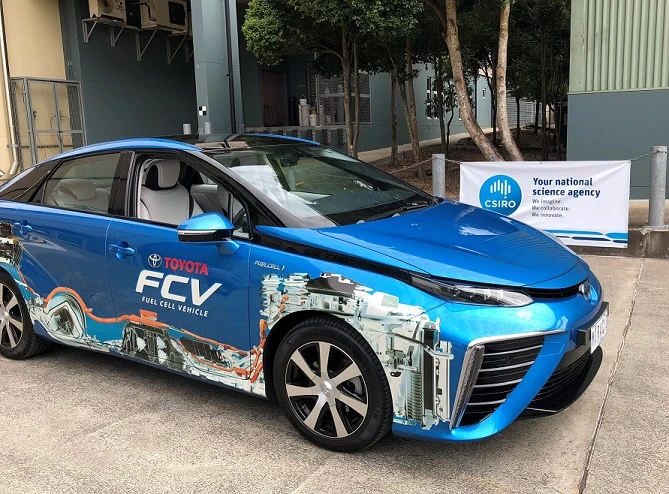Home-Grown Zero-Carbon Hydrogen Technology

CSIRO’s Toyota Mirai HFC vehicle (image from CSIRO)
There are three possibilities when it comes to finding an alternative to the standard fossil fuels used in the majority of vehicles on the road. The first is a switch to biofuels (biodiesel, ethanol, etc.), the second is to go electric (the sexy new technology that’s mushrooming) and the third is hydrogen fuel cells or HFCs.
I discussed the basics of HFCs in my previous post. If you can’t remember or if you can’t be bothered hopping over to have a look, one of the points I raised was that most of the hydrogen gas used to power HFCs comes from natural gas, with methane (from sewage and effluent) coming in as the more sustainable second possibility. However, there’s another possible source of the hydrogen fuel that’s being worked on by our very own CSIRO researchers right here in Australia: ammonia.
Most of us are familiar with ammonia as the thing that makes floor cleaners (a) really cut through grease and (b) smell horrible. However, ammonia is also produced as a waste product by living cells and in humans, it quickly turns into urea and is excreted as urine. In fact, some of the pong associated with old-school long-drop dunnies comes from the urea in urine breaking back down into ammonia again (the rest of the smell comes from methane and some sulphur-based compounds, depending on what you’ve been eating).
Ammonia is chemically rendered as NH3, which should tell you straight away that there are three nice little hydrogen atoms just waiting to be turned into hydrogen gas; the leftover nitrogen is also a gas –and that’s one of the most common elements in the atmosphere (it makes up three-quarters of the earth’s atmosphere, in fact). Yes, ammonia in its pure form is a gas (the liquid stuff in household products is in the form of ammonium hydroxide or ammonia mixed with water). The fun here from the perspective of HFC technology consists of splitting the ammonia gas up into nitrogen gas and hydrogen gas, and then separating the two.
And this is precisely what the ammonia-to-hydrogen team at CSIRO have been working on. In August year, they made the big breakthrough by developing a membrane-based technology that will convert ammonia into hydrogen gas. The hydrogen gas can then be used by vehicles powered by HFC technology. The bit they’re all rubbing their hands with glee about is because up until now, one of the obstacles with getting HFC-powered motoring off the ground is that it’s hard to transport hydrogen gas from wherever it’s produced to the hydrogen equivalent of a bowser. However, ammonia is a lot easier to get from A to B. This means that with this home-grown technology, Australia will be able to export hydrogen (in the form of ammonia during transport) to the markets that want it.
Asia seems to be the hot spot for vehicles using HFC technology, with Toyota and Hyundai really getting behind the tech; European marques, on the other hand, seem to be concentrating on electric vehicles. In fact, Japan is eyeing up hydrogen as a source of energy for generating power for homes as well.
The question has to be asked where they’re going to get all this ammonia from. However, it’s possible to take nitrogen gas and water, then zap it with electrical current and turn it into ammonia – and it was an Australian researcher who came up with the tech to do this. It’s kind of like a fuel cell – which breaks down gas to produce electricity – but in reverse: using electricity to produce ammonia. The new Australian technology is considered to be an improvement over the traditional method of producing ammonia (which is needed for making the fertilizer that grows the food you eat), which takes hydrogen gas from fossil fuels and reacts it, spitting out a good deal of CO2 in the process. The new Aussie tech skips the bits involving carbon in any form, as it takes nitrogen from the atmosphere (N2) and water (H2O) and puts out NH3 and O2. O2 is oxygen – what we breathe.
The idea is that in the future, they’ll set up a plant or two in the middle of the outback where there’s lots of solar and wind energy available for generating electricity, pump in some H2O and get ammonia for export AND use in hydrogen cars thanks to the new membrane tech out the other end with zero carbon emissions. It could be asked where they’re going to get the water from in the middle of the Outback but I suppose that it’s not essential to use clean, fresh drinking water for the process, as it’s pretty easy to distil pure water out of wastewater. In fact, one has the very happy vision of a process that takes sewage from cities, whips out the ammonia, urea and methane already in there (bonus!), distils out the water for making more ammonia and exporting the lot; any solids can probably also be used for fertilizer.
It’s going to take a little while for all the systems to get into place. It’s still very early days for HFC vehicles but a start has been made and some of the hurdles have been overcome. A few HFC vehicles have made it onto these shores. The analysts say that it will probably take another decade or so until HFC cars become common on our roads but it’s likely to happen. Look what happened with electric vehicles, after all. Once they were really rare but now there’s charging points just about everywhere you look.
You can find more information here , here and here .